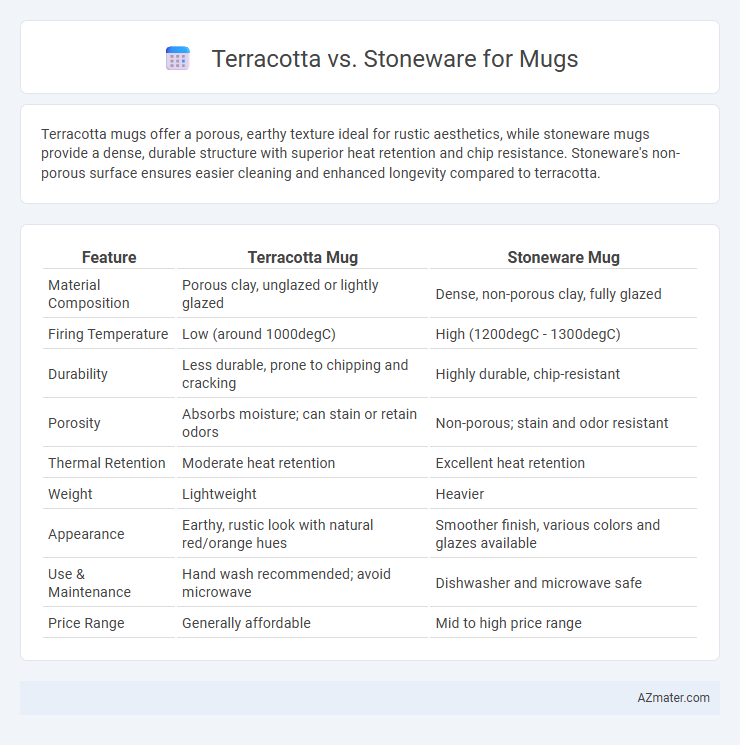Terracotta mugs offer a porous, earthy texture ideal for rustic aesthetics, while stoneware mugs provide a dense, durable structure with superior heat retention and chip resistance. Stoneware's non-porous surface ensures easier cleaning and enhanced longevity compared to terracotta.
Table of Comparison
| Feature | Terracotta Mug | Stoneware Mug |
|---|---|---|
| Material Composition | Porous clay, unglazed or lightly glazed | Dense, non-porous clay, fully glazed |
| Firing Temperature | Low (around 1000degC) | High (1200degC - 1300degC) |
| Durability | Less durable, prone to chipping and cracking | Highly durable, chip-resistant |
| Porosity | Absorbs moisture; can stain or retain odors | Non-porous; stain and odor resistant |
| Thermal Retention | Moderate heat retention | Excellent heat retention |
| Weight | Lightweight | Heavier |
| Appearance | Earthy, rustic look with natural red/orange hues | Smoother finish, various colors and glazes available |
| Use & Maintenance | Hand wash recommended; avoid microwave | Dishwasher and microwave safe |
| Price Range | Generally affordable | Mid to high price range |
Introduction to Terracotta and Stoneware Mugs
Terracotta mugs are crafted from porous, natural clay that offers a rustic aesthetic and excellent heat retention, ideal for traditional beverage experiences. Stoneware mugs, made from dense, vitrified clay fired at high temperatures, provide durability, resistance to chipping, and a smooth, non-porous surface that preserves flavors. Choosing between terracotta and stoneware involves balancing the earthy, handcrafted appeal of terracotta with the robust, modern practicality of stoneware on a daily use basis.
Material Composition and Manufacturing Process
Terracotta mugs are crafted from porous clay that is fired at lower temperatures, typically between 1000degC and 1150degC, resulting in a more delicate, earthy material that retains heat well but requires sealing to prevent water absorption. Stoneware mugs are made from a denser, non-porous clay mixture fired at higher temperatures ranging from 1200degC to 1300degC, producing a durable, vitrified material resistant to chipping and moisture. The manufacturing process of stoneware involves longer firing times and higher heat, creating a stronger, more resilient surface ideal for everyday use.
Appearance and Aesthetic Differences
Terracotta mugs typically feature a warm, earthy red or orange hue with a matte, porous surface that highlights their rustic, handcrafted charm, making each piece unique with slight color variations. Stoneware mugs exhibit a broader color palette, from deep browns to muted grays and blues, often finished with a glossy or satin glaze that enhances durability and a more refined, polished aesthetic. The rough texture of terracotta contrasts with the smoother, denser feel of stoneware, appealing to different design preferences and atmospheres in kitchenware collections.
Durability and Strength Comparison
Stoneware mugs offer superior durability and strength due to their dense, non-porous composition fired at higher temperatures, making them resistant to chipping and cracking. Terracotta mugs, made from porous clay fired at lower temperatures, are more fragile and prone to damage with regular use. For long-term use and robustness, stoneware is the preferred material over terracotta in mug production.
Heat Retention and Insulation Properties
Terracotta mugs offer moderate heat retention due to their porous structure, allowing some heat to escape and thus cooling beverages faster. Stoneware mugs provide superior insulation with dense, non-porous ceramics that keep drinks hot longer and maintain temperature evenly. Choosing stoneware over terracotta enhances heat retention for prolonged enjoyment of hot beverages.
Porosity and Water Absorption Rates
Terracotta mugs exhibit higher porosity and water absorption rates, typically absorbing up to 10-15% water due to their porous clay composition, making them more susceptible to moisture retention and potential staining. Stoneware mugs have much lower porosity, usually below 5%, resulting in better water resistance, enhanced durability, and reduced likelihood of cracking or absorbing liquids. This makes stoneware a more practical choice for mugs intended for frequent use and liquid containment.
Suitability for Hot and Cold Beverages
Terracotta mugs offer excellent thermal insulation, making them suitable for hot beverages by retaining heat longer, while their porous nature requires glazing to prevent absorption of liquids. Stoneware mugs provide superior durability and are inherently non-porous, making them ideal for both hot and cold beverages as they resist temperature changes and maintain beverage flavor without imparting any taste. Both materials differ in heat retention and maintenance, but stoneware's versatility and sturdiness often make it a preferred choice for everyday use with a wide range of beverage temperatures.
Ease of Cleaning and Maintenance
Terracotta mugs are porous, making them prone to retaining stains and odors, which requires careful handwashing and regular sealing to maintain cleanliness. Stoneware mugs have a non-porous, glazed surface that resists stains and odors, allowing for easier cleaning, often being dishwasher safe. The low maintenance and durability of stoneware make it more convenient for daily use compared to terracotta.
Cost and Availability of Terracotta vs Stoneware
Terracotta mugs generally offer a more affordable option compared to stoneware, with prices often 20-40% lower due to simpler production processes and abundant raw materials like natural clay. Stoneware, known for durability and heat retention, tends to be pricier and less widely available, especially in regions where advanced ceramic glazing techniques are less common. Availability of terracotta is widespread in rural and artisanal markets, whereas stoneware is predominantly found in specialized ceramic stores and higher-end kitchenware outlets.
Choosing the Right Mug: Which Is Best for You?
Terracotta mugs offer excellent heat retention and a rustic aesthetic, making them ideal for those who appreciate traditional craftsmanship and earthy textures. Stoneware mugs provide superior durability, chip resistance, and often feature smooth glazes, perfect for everyday use and easy cleaning. Choosing the right mug depends on your preference for style, maintenance, and thermal performance, with terracotta suiting artisanal charm and stoneware excelling in practicality.

Infographic: Terracotta vs Stoneware for Mug
 azmater.com
azmater.com